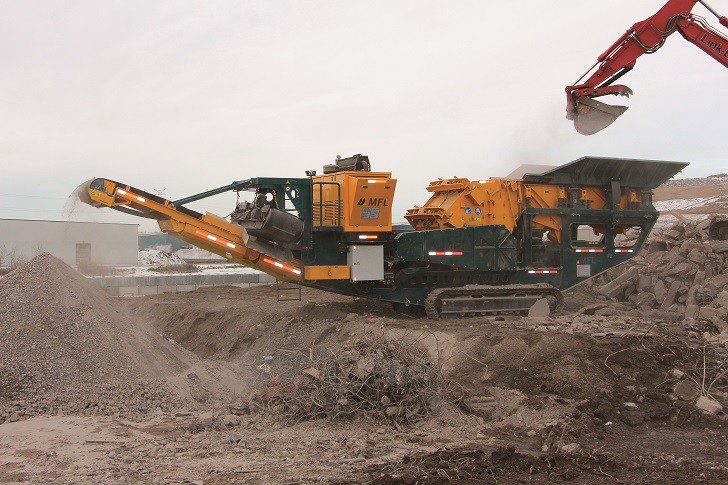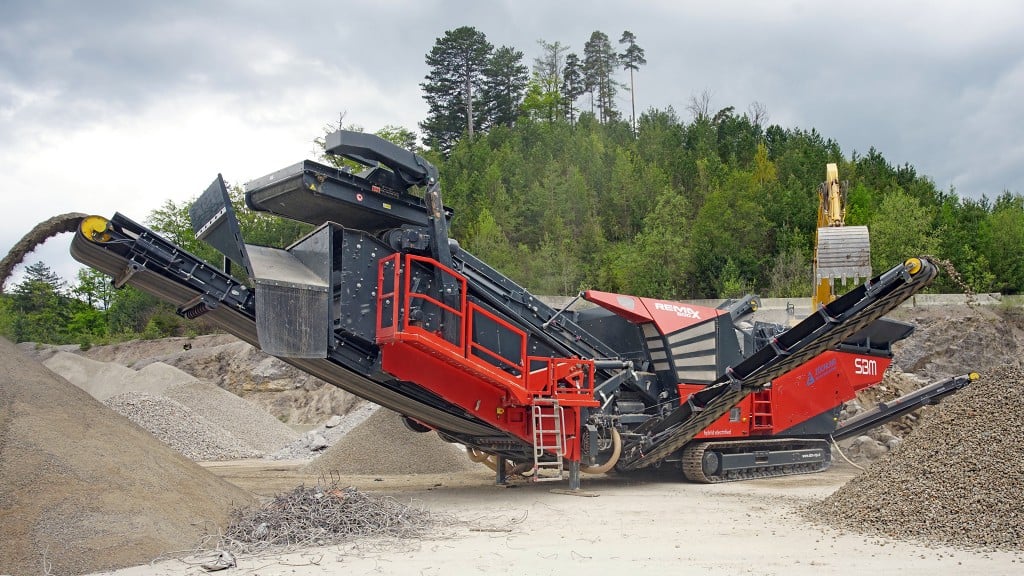
A mobile impact crusher manufactured by SBM MineralProcessing out of Austria is currently being used on a trial basis to produce 2.5-inch aggregate at the world renowned Edmonton Waste Management Centre (EWMC) – adding to the city’s reputation as a leader in the recycling of C&D debris.
In November, 2014 Terrafirma Equipment Sales and Rentals, the Edmonton based heavy-equipment dealer involved in the project, provided a tour for a small group consisting of representatives from Terrafirma, SBM and the City of Edmonton. Recycling Product News was also invited along to see the crusher in action.
For the trial, an SBM RCI 100.130TV mobile impact crusher has been set up to process a waste pile interspersed with rebar, large chunks of concrete and steel. The metal is being separated from crushable material and the finished product – 2.5-inch (63mm) minus aggregate – will be used as road-base on EWMC roads and others throughout the Edmonton area.
“The product that comes out is awesome. The first time you pass it through, it gets right to the product. You don’t have to repass it twice,” says Dan Lefebvre, an independent contractor hired by the City of Edmonton to run the crusher. “When the city came and took samples they said it’s the best they’ve seen in 20 years.”
The City of Edmonton has an active aggregates recycling program run through three sites. Since it began in 1978, Edmonton has recycled around 4.6 million tonnes of aggregate, with the majority of the material coming from construction sites and about 15 percent from residences. Approximately 99 percent of the aggregate rubble produced by the city is recycled, saving significant landfill space.
Annually, Edmonton stockpiles some 200,000 tonnes of crushed concrete and asphalt, as well as approximately 4,000 tonnes of steel. According to the city, the steel component is important because it pays for the agg-recycling program without having to use tax dollars. Not only that, but the program is estimated to save the city around $15 million per year, based on current replacement costs for natural aggregate and landfill cost savings. The city also saves by not having to truck in aggregate used in roadbuilding and building construction.
Less trucks means less greenhouse gas emissions, making the program all the more appealing to local politicians and taxpayers.
“You start doing the numbers and it adds up really quick that we’re doing the right thing,” says Blair Buchholtz, general supervisor of aggregate recycling operations with the City of Edmonton.
As SBM’s impact crusher is put through its paces at the EWMC, Buchholtz said he sees real potential in the machine’s ability to crush the aggregate needed to meet the province of Alberta’s new chip standard for road surfaces.
Edmonton currently buys its chip and high-performance aggregates from a quarry in Rocky Mountain House, Alberta, but it’s more expensive than what the city can produce internally through its recycling operations.
“Whatever we haul in as crushed stock, every part of that material will get used in one of my operations. So there’s less waste for us and we can crush at a lower cost because we have all our infrastructure in place. It ends up being a lot more beneficial financially and logistically,” says Buchholtz.
He said the city plans to use the RCI 100.130TV crusher (or a similar unit) in conjunction with a screening plant to reduce material down to the 63-mm to 8-mm chip standard now required by the province.
“If we’re using it for that material, number one we don’t have to worry about cleaning rebar off the spinners or the blow bars. And based on the digestability and the way we can flip the blow bars within the unit, and the wear plates, it seems to make a lot more sense than the other units I’ve seen,” Buchholtz says. “I know we want to run some more trials on it, but from initial appearances and the specifications that we’ve had a look at, it seems to be a pretty easy decision to use this crusher on our spread.”
“We’re using it on a trial basis and we’ll look at purchasing either that one or one similar to it so we can produce the new chip-standard material.” Norbert Dieplinger, international business development manager with SBM (a member of the MFL Group) notes that one of the machine’s main advantages to customers is its ability to crush material using less steps.
A traditional approach is to use a jaw crusher to pre-crush material before it is fed into cone crushers to reduce it to the required specification.
“MFL’s mobile impact crushers roll four processes into one,” says Dieplinger. “After the cone material is a little bit flaky so they have to use vertical shaft impactors to shape it. So in the end we’re talking about four stages just to get this one product,” he said. “[With the MFL crusher] If you feed in five-inch material after crushing it in the first round you will get about 60 percent 3/8- to half-inch material, so everything up to 98 percent is already in a perfect cubical shape. It’s material that you can use right away.”
Dieplinger also notes that the machine runs on a diesel-electric drive versus diesel hydraulics, saving operators about 30 percent in fuel costs and reducing the overall environmental footprint.
“They can connect every mobile plant of ours directly to the mains without running the diesel engine,” he says. “If you run it just with electricity it’s very clean machinery.”



